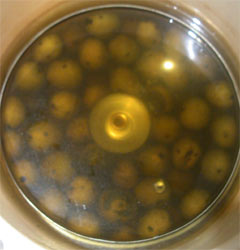The Pickled Walnuts project. Stage one.
Posted by Fiona Nevile in Chutney and Pickles | 11 comments “What on earth are you doing, Fiona?”
“What on earth are you doing, Fiona?”
I was sitting on the floor on a large plastic sheet, wearing rubber gloves and stabbing green walnuts on an old bread board with a carving fork. No wonder Tessa was intrigued.
I’ve been desperate to get my hands on some green walnuts for years. About 10 days ago I spotted some on a friend’s tree. It was just at the end of the picking green walnuts season.
“Take all you like but hurry or they’ll be too hard to pickle.”
She picked one and sliced it firmly with a gardening penknife.
“You’re in luck, they’re still just soft enough,” she smiled. “Come in and taste my pickled walnuts. I haven’t made them for a couple of years but I know that I’ve got some in my larder.”
I knew from the wobble of her head when she produced the chunky jar that these would be good.
“The trick is to use some sugar in your recipe. Most of the commercially produced ones are far too tart. The vinegar that you choose makes a big difference too.”
We searched in vain for her recipe. Then she remembered that she lent her book to a Swedish friend who was returning to Stockholm.
So I scuttled off with a bulging carrier bag of walnuts and a lot of hope.
A quick foray on the Internet indicated that pickled walnuts are an acquired taste. The recipes are as diverse as they are rare. This was the perfect opportunity to make up my own recipe. HFW soaks his in a brine solution for a week, changing the solution every couple of days. Others soak the walnuts for a couple of weeks or so, changing the brine solution after seven days. As the walnuts were not picked until the end of July, I chose the longer soaking method.
They have soaked for a week now (with a glass saucepan lid keeping them under the saline solution – 150g of salt to each litre of water). I changed the saline solution this morning. Pouring the old solution into the bath and rinsing the bath immediately. The old solution has to be handled with care as the walnut juice stains dark brown any porous surface that it touches. Apparently, walnut juice makes a great hair dye. The only problem is that it stains your scalp too.
After the walnuts have soaked for a couple of weeks they are rinsed, packed into a jar, covered with vinegar infused with spices and left to mature. My recipe will be contained in stage two next week and reviewed around Christmas when they’ll finally be ready to eat.
I have great fun playing around with pickles and chutneys. If you get the preserving elements in place (salt and/or vinegar) you can be totally wanton with the combination of spices and create your own recipes. As preserves mature they change and usually improve, so each recipe is a long term project. Old fashioned luggage labels are invaluable for keeping notes attached to a jar.
I try to make chutney and pickles that are good to eat without a long wait. But often remember the story of the original Lea and Perrins Worcestershire Sauce, discarded and forgotten for years and then rediscovered with relish. The recipe still takes 18 months to mature.
Leave a reply





Just found this thread and wondered what the results were like. I shall certainly have ago as i have friends with a tree and they don’t pick anything.